ICSE Solutions for Class 8 History and Civics – The Union Legislature
ICSE SolutionsSelina ICSE SolutionsML Aggarwal Solutions
APlusTopper.com provides step by step solutions for ICSE Solutions for Class 8 History and Civics. You can download the History and Civics ICSE Solutions for Class 8 with Free PDF download option. History and Civics for Class 8 ICSE Solutions all questions are solved and explained by expert teachers as per ICSE board guidelines.
ICSE Solutions Class 8 History & Civics GeographyBiologyChemistryPhysicsMaths
I. Fill in the blanks:
- The elections to the Lok Sabha are held by secret ballot.
- A person should have acquired the age of 25 years of age to become a Member of Lok Sabha.
- The maximum strength of the members of Lok Sabha is 545 members.
- The Rajya Sabha is the upper House of Parliament.
- The President can nominate 12 members members in the Rajya Sabha.
II. Match the contents of Column A with those of Column B.
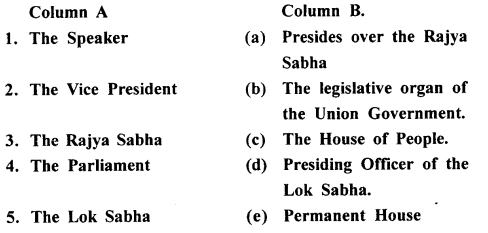
Answer:
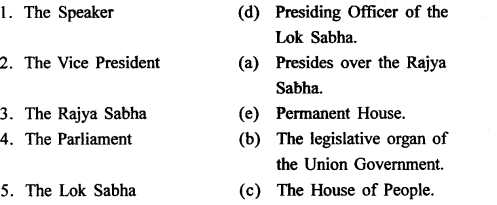
III. Tick mark (✓) the correct statements and cross mark (X) the wrong ones.
- The Rajya Sabha is presided over the Vice President of India.
✓ - A money bill has to be moved first in the Lok Sabha.
✓ - The Parliament meets at least twice a year.
✓ - The members of the Rajya Sabha are elected for a term of six years.
✓
IV. Answer the following questions:
Question 1.
Name the two Houses of the Union Parliament|
Answer:
The two houses of Parliament are
- Lok Sabha
- Rajya Sabha.
Question 2.
How are the members to the Lok Sabha elected?
Answer:
The members of the Lok Sabha are elected directly through a secret ballot by adult citizens for five years.
Question 3.
What is a bicameral legislature?
Answer:
Bicameral Legislature means a parliament has two houses-the Upper House and the Lower House. Our parliament consists of two Houses, therefore ours is a bicameral Legislature.
Question 4.
Mention the essential qualifications for a person to be a member of the Lok Sabha.
Answer:
Qualifications for Membership to the Lok Sabha:
- He must be a citizen of India.
- He should not be less than 25 years of age.
- He should be mentally sound.
- He should not be an insolvent, i.e., he should not be in debt and should have the ability to meet his financial commitments.
- He should not hold an office of profit under the government.
- He should not be a proclaimed offender.
- He should have his name in the electoral rolls in some part of the country.
Question 5.
What is the composition of the Rajya Sabha ?
Answer:
Rajya Sabha is the Upper House. It is also called council of states. The maximum strength of the Rajya Sabha can be 250 members. Of these 238 are elected by the elected members of the State Legislative Assemblies. The remaining 12 members are nominated by the President of India from among men of repute in various spheres of life e.g. science, technology literature and social work.However, at present, the Rajya Sabha consists of 245 members, out of which 233 are elected and 12 members are nominated by the President.
Question 6.
What are the functions of the Lok Sabha?
Answer:
The Functions of the Lok Sabha
- Legislative Functions: They pass bills and make laws. Any bill regarding subjects in the Union or the Concurrent List of the Constitution may be moved in this House.
- Financial Powers: The House of People controls the treasury. No budget or government expenditure can be made without the permission of the House. A money bill has to be moved only in the Lok Sabha.
- Control over the Council of Ministers: The council of ministers is responsible to the Lok Sabha. It may remain in power only so long as it enjoys the confidence of the Lok Sabha.
Question 7.
Describe the law making functions of the Parliament.
Answer:
The Union Parliament is law-making organ of the Union Government. Besides, it has to perform many more functions.
- It frames new laws and amends or cancels them, if necessary, on all the 97 subjects of the Union List and all the remainder subjects which have not found a place in any of the lists.
- In certain cases, it can make laws on the subjects of the State List also.
- The Parliament along with the State Legislature can pass laws regarding the 47 subjects on the Concurrent List.
- The Union Parliament has the sole right to amend the Constitution, although in certain cases, these amendments need to be ratified by a majority of the states.
Question 8.
How does the Parliament exercise control over the Government?
Answer:
The most important function of the Parliament is to exercise control over the government.
- The government is directly responsible to the Parliament for its acts of omission and commission. The government can be voted out of office by passing a vote of no confidence against the Prime Minister or the Ministry or any of its members.
- The Members of Parliament can also move adjournment motions. An adjournment motion is tabled when there is an urgent matter that needs the immediate attention of the government. If admitted, a time a set aside from normal business of the house for discussing the matters of urgent public importance.
- The members can ask any question relating to the administration of the state and the ministers are obliged to answer them. In this way, they can keep a check on the functioning of the various departments under different ministers.
- The Parliament can also hold the strings of the government tight by voting a cut in the annual budget.
V. Write short notes on the following:
Question 1.
Adjournment motion
Answer:
Daily business of the House is programmed well in advance and is considered accordingly. But if a question of immense public importance crops up, the members can demand adjournment of the discussion on slated business and discuss that matter immediately.
Question 2.
Universal Adult Franchise
Answer:
Adult Franchise means that the right to vote should be given to all adult without discrimination on the basis of caste, class, colour, religion or sex. It is based on equality which is the basic principle of democracy.
Question 3.
Secret Ballot
Answer:
Secret Ballot is a voting method in which a voter’s choice in an election or referendum is anonymous forestalling attempts to influence the voter by intimidation, blackmailing and potential vote buying. Printed ballot papers are provided with names of the candidates. Provisions are made at the polling place for the voter to record their preferences in secret and the ballots are designed to eliminate bias and to prevent any one from influencing a voter.
Additional Questions
EXERCISES
A. Fill in the blanks:
- The functions of the government are divided into three branches, namely, the Legislature, the Executive and the Judiciary.
- Subjects for legislation are divide into three lists-the Union List, the State List and the Concurrent List.
- The Union Parliament has two Houses-the Lok Sabha and the Rajya Sabha.
- The Rajya Sabha is a permanent house. It cannot be dissolved.
- The Parliament is answerable to the legislature.
B. Match the following:
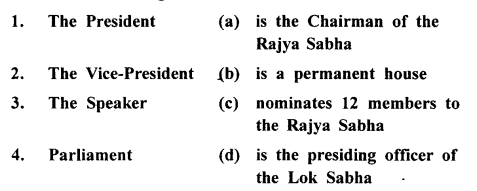

Answer:
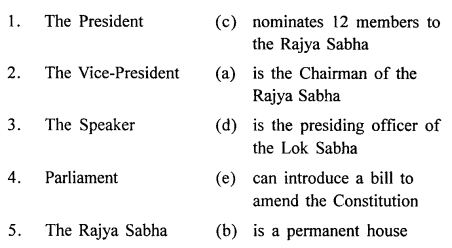
C. Choose the correct answer:
- The President carries out his/her functions on the advice of the Prime Minister and the Lok Sabha/the Council of Ministers/the Rajya Sabha.
Ans. The President carries out his/her functions on the advice of the Prime Minister and the Council of Ministers. - Both the central and the state governments can make laws on the subjects in the Union List/State List/Concurrent List
Ans. Both the central and the state governments can make laws on the subjects in the Concurrent List. - The Lok Sabha/Rajya Sabha/Vidhan Sabha is also known as the Council of States
Ans. The Rajya Sabha is also known as the Council of States. - The President can nominates 2/10/12 members from the Anglo-Indian community to the Lok Sabha.
Ans. The President can nominates 2 members from the Anglo-Indian community to the Lok Sabha. - At present the Lok Sabha consists of 454/645/525
Ans. At present the Lok Sabha consists of 545 members.
D. State whether the following are true or false:
- The State List includes subjects of national importance.
False. - A member of the Lok Sabha should be at least 30 years of age.
True. - The Rajya Sabha is a permanent House and cannot be dissolved by the President.
True. - The money bill has to be introduced in the Rajya Sabha.
False. - The Vice-President is the presiding officer of the Rajya Sabha.
True.
E. Answer the following questions in one or two words/ sentences:
1. Who is the nominal executive head of the government of India?
Ans. The President of India, is only a nominal executive head of the government of India
2. How do we know that the Parliament has supreme authority in the government?
Ans. The Lok Sabha exercise control over the Council of Ministers which is responsible and answerable to the Lok Sabha for all its policies, decisions and actions. This makes the Parliament the supreme authority in the government because it has the final authority to accept or reject the decisions of the executive.
3. Which branch of government interprets and defines laws?
Ans. Judiciary defines and interprets the laws of the land and tries to prevent any person from violating the laws of the Constitution.
4.What is the minimum age qualification of an Indian voter?
Ans. All Indian citizens, 18 yeas of age or above, have the right to vote.
5.Who conducts the meetings of the Lok Sabha?
Ans. The Speaker conducts the meetings of the Lok Sabha
6. How are the members of the Rajya Sabha elected?
Ans. These members are elected indirectly by the elected members of the State Legislative Assemblies.
Twelve members are nominated by the President from among persons who have distinguished themselves in the fields of art literature, science or social service.
7. What is meant by the term ‘budget’?
Ans. The budget is an estimate of the annual income and expenditure of the government of India.
8. What happens when a vote of no-confidence is passed against the Council of Ministers ?
Ans. Vote of no-confidence is a move in the Lok Sabha to express a lack of confidence in the Council of Minister. If such a motion is passed, then the Council of Ministers has to resign.
9.Explain the meaning of the term ‘quorum’.
Ans. Quorum refers to the minimum number of members required to be present to conduct a meeting.
F. Answer the following questions briefly:
Question 1.
In the context of the Parliamentary form of government, answer the following questions:
(a) What are the main features of the parliamentary form of government?
Answer:
Features of the parliamentary form of government:
- Under this system there is very close relationship between the executive and legislature.
- All the members of the executive are the elected members of the majority party in the legislature.
- After the general elections the elected representatives of the
- people of India form the Lok Sabha.
- Subsequently, the council of Ministers is formed out of the elected members of the Lok Sabha.
(b) Name the three branches of government and state their respective functions.
Answer:
According to the Constitution, the powers and functions of the government are divided into three branches-the legislature, the executive and the judiciary.
The powers and functions are distributed among these branches in a manner that makes them equally balanced.
India is a parliamentary democracy. The Parliament, which is composed of the elected representatives of the Indian people, is vested with supreme power. The Parliament is the highest law making body and it makes laws for the entire country. Thus the Indian people enjoy supreme power through their representatives in the Parliament.
In a parliamentary form of government, there is a very close relationship between the legislature and the executive.
After the general elections, the elected representatives of the people form the Lok Sabha. The President appoints the leader of the majority party or the single largest party or group of parites within the Lok Sabha as the Prime Minister. Generally, the Prime Minister chooses his/her Council of Ministers from among the elected members of the Lok Sabha. He/she may also choose a Rajya Sabha members as a minister.
The Lok Sabha exercise control over the Council of Ministers which is responsible and answerable to the Lok Sabha for all its policies, decisions and actions. This makes the Parliament the supreme authority in the government because it has the final authority to accept or reject the decisions of the executive
(c) Why are powers distributed between the central and the state governments?
Ans. As India is a vast country, it is not possible for one central government to take care of the specific needs of people living in different parts of the country. Therefore, the country has been divided into different units, which are called states. Each state has a state government and the processes of the government are shared by the central government and the state governments.
The parliamentary form of government is also present in the states. The pattern is the same-the state executive is formed out of the state legislature, whose members are directly elected by the people
Question 2.
Give an account of the Lok Sabha with reference to:
(a) Its composition
(b) Basic qualifications of its members
(c) Its term
Answer:
(a) Composition:
- The maximum strength of the Lok Sabha can be 552 members.
- A maximum of 530 members can be elected directly by the people of India from different territorial constituencies.
- A maximum of 20 members can be elected from the union territories.
- The President can nominate two members from the Anglo-Indian community.
- At present, the Lok Sabha consists of 545 members
(b) Basic qualifications of its members:
- Should be a citizen of India.
- Should be at least twenty-five years of age.
- Should not be holding an office of profit under the government.
(c) Its term:
The Lok Sabha is elected for a 5-year term. However, the President may dissolve it before the expiry of its term if the party in power loses the support of the majority. Its life can be extended for 1 year at a time in case of a national emergency.
Question 3.
Give an account of the Rajya Sabha with reference to :
(a) Its composition
(b) Basic qualifications of its members
(c) Its term
Answer:
(a) Its composition:
- The maximum strength of the Rajya Sabha can be 250 members.
- 238 members represent the states and the union territories. Seats are allotted to each state according to its population. These members are elected indirectly by the elected members of the State Legislative Assemblies.
- Twelve members are nominated by the President from among persons who have distinguished themselves in the fields of art, literature, science or social service.
(b) Basic qualification of the Members of the Rajya Sabha :
- Should be citizens of India
- Should be at least 30 years of age
- Should be registered voters
(c) Its term:
The Rajya Sabha is a permanent House. It cannot be dissolved by the President. Each member is elected for a period of 6 years. One third of its members retire every 2 years. Members can be re-elected.
Question 4.
With reference to the functions of the Parliament, explain the following:
(a) Law-making functions
(b) Control over the executive
(c) Judicial functions
Answer:
(a) Law making functions of the Parliament:
- The Parliament can frame new laws or modify existing ones on any subject in the Union or Concurrent List.
- In some cases the Parliament can also pass laws on subjects under the State List.
- Only the Parliament can initiate a Bill to amend the Constitution.
(b) Control over the Council of Ministers:
- The Parliament keeps a watch over the government. The Council of Ministers is directly responsible and answerable to the Lok Sabha for its policies and actions.
- The Council of Ministers has to resign immediately if a vote of no-confidence is passed against it by the Lok Sabha.
- The Members of Parliament can discuss government policies and question the ministers. Hence, they can exercise a check on the working of the government.
- The Parliament can move an adjournment motion to discuss and focus on any matter of public importance which requires immediate and urgent attention from the government, for instance, natural disasters such as earthquakes and unforeseen situations such as police firing or terrorist attacks, etc.
(c) Judicial Functions of the Parliament:
The Parliament can impeach or remove the President, the Vice-President and judges of the Supreme Court and High Courts if any of them violate the Constitution or misuse their authority.
G Picture study:
This is the picture of an important government building in India.
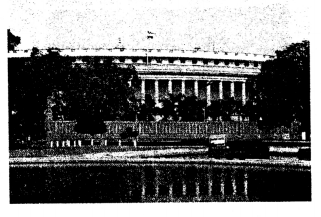
Question 1.
Identify the building.
Answer:
House of the People (Parliament House).
Question 2.
Which branch of the government functions in this building?
Answer:
Lok Sabha.
Question 3.
Who are the members of this branch of the government?
Answer:
Elected representatives of the people of India are the members of this branch. The lower house of the Parliament is the Lok Sabha. The maximum strength of the Lok Sabha can be 552 members.
- A maximum of 530 members can be elected directly by the people of India from different territorial constituencies.
- Not more than 20 members can be elected from the union territories.
- The President can nominate two members from the Anglo- Indian Community.
- At present, Lok Sabha consists of 545 members.
Question 4.
What are the basic qualifications of the members?
Answer:
A member of the Lok Sabha:
- Should be a citizen of India
- Should be at least 25 years of age.
- Should be a registered voter
Question 5.
What is their primary function? Mention any two other important functions.
Answer:
The Primary Functions of Parliament house are:
- The Parliament can frame new laws or modify existing ones on any subjects in the Union or Concurrent List.
- No money can be raised or spent without the approval of the Lok Sabha.
- In some cases, the parliament can also pass laws on subjects under the State List.
- Only the Parliament can initiate a Bill to amend the Constituion.
The other two important functions are:
(a) Judicial Function
(b) Elective Function